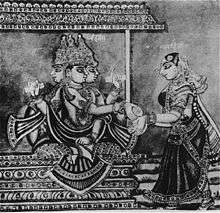Aditi
| Aditi | |
|---|---|
| Mother of the Gods | |
 Brahma with Aditi (right) | |
| Weapons | Sword, Trishula |
| Consort | Kashyap |
| Children |
Ādityas Vamana |
| Mount | Rooster |
| Texts | Rigveda |
In the Vedas, Aditi (Sanskrit: अदिति "limitless")[1] is mother of the gods (devamata) and all twelve zodiacal spirits from whose cosmic matrix the heavenly bodies were born. As celestial mother of every existing form and being, the synthesis of all things, she is associated with space (akasa) and with mystic speech (Vāc). She may be seen as a feminized form of Brahma and associated with the primal substance (mulaprakriti) in Vedanta. She is mentioned nearly 80 times in the Rigveda: the verse "Daksha sprang from Aditi and Aditi from Daksha" is seen by Theosophists as a reference to "the eternal cyclic re-birth of the same divine Essence"[2] and divine wisdom.[3] In contrast, the Puranas, such as the Shiva Purana and the Bhagavata Purana, suggest that Aditi is wife of sage Kashyap and gave birth to the Adityas such as Indra, Surya, and also Vamana.[4]
Origin
The name is mentioned in Vedas as mother of Surya (Sun) and other celestial bodies or gods Adityas (meaning sons of Aditi).
The first mention of goddess Aditi is found in Rigveda, which is estimated to have been composed roughly during 1700-1100 BC.[5]
Attributes
Motherhood
Aditi is said to be the mother of the great god Indra, the mother of kings (Mandala 2.27) and the mother of gods (Mandala 1.113.19). In the Vedas, Aditi is Devamata (mother of the celestial gods) as from and in her cosmic matrix all the heavenly bodies were born. She is preeminently the mother of 12 Adityas whose names include Vivasvān, Aryamā, Pūṣā, Tvaṣṭā, Savitā, Bhaga, Dhātā, Vidhātā, Varuṇa, Mitra, Śakra, and Urukrama (Vishnu was born as Urukrama, the son of Nabhi and Meru.)[6] She is also the mother of the Vamana avatar of Vishnu. Accordingly, Vishnu was born as the son of Aditi in the month of Shravana (fifth month of the Hindu Calendar, also called Avani) under the star Shravana. Many auspicious signs appeared in the heavens, foretelling the good fortune of this child.
In the Rigveda, Aditi is one of the most important figures of all. As a mothering presence, Aditi is often asked to guard the one who petitions her (Mandala 1.106.7; Mandala 8.18.6) or to provide him or her with wealth, safety, and abundance (Mandala 10.100; 1.94.15).
Creativity
Aditi is usually mentioned in the Rigveda along with other gods and goddesses. There is no one hymn addressed exclusively to her, unlike other Vedic gods. She is perhaps not related to a particular natural phenomenon like other gods. Compared to Usha and Prithvi, Aditi can be defined as the cosmic creatrix, the creativity of the all-creating.
Freedom
The name Aditi includes the root "da" (to bind or fetter) and suggests another attribute of her character. As A-diti, she is un-bound, free one, and it is evident in the hymns to her that she is often called to free the petitioner from different hindrances, especially sin and sickness. (Mandala 2.27.14). In one hymn, she is asked to free a petitioner who has been tied up like a thief (Mandala 8.67.14). As one who unbinds, her role is similar to her son Varuna's as guardian of Rta, cosmic moral order. She is called the supporter of creatures (Mandala 1.136). It also means 'one of its kind' or 'unique.'
Might
Aditi challenges the modern idea that the Vedic peoples were patriarchal. Aditi was regarded as both the sky goddess, and earth goddess, which is very rare for a prehistoric civilization. Most prehistoric civilizations venerated a dual principle, Sky Father and Earth Mother, which appears to be borrowed from the concept of Prithivi and Dyaus Pita. Aditi was attributed the status of first deity by the Vedic culture, although she is not the only one attributed this status in the Vedas. She is addressed, in the Rigveda as "Mighty".
Others
Like many other Hindu gods and goddesses, Aditi has a savari (a mount). Aditi flies across the boundless sky on a rooster . The rooster symbolizes strength and honour. Her weapons include the famous Trishul and a sword.
References
- ↑ From a- (privative a) and diti "bound," which is from the Proto Indo-European root *da- "to bind."
- ↑ The Secret Doctrine 2:247n
- ↑ "Adi-Ag: Encyclopedic Theosophical Glossary". Theosociety.org.
- ↑ Gopal, Madan (1990). K.S. Gautam, ed. India through the ages. Publication Division, Ministry of Information and Broadcasting, Government of India. p. 62.
- ↑ Oberlies (1998:155) gives an estimate of 1100 BC for the youngest hymns in book 10. Estimates for a terminus post quem of the earliest hymns are more uncertain. Oberlies (p. 158) based on 'cumulative evidence' sets wide range of 1700–1100
- ↑ "Srimad Bhagavatam Canto 6 Chapter 6 Verses 38-39". Vedabase.net. Retrieved 2012-08-13.
Further reading
- Kinsley, David. Hindu Goddesses: Vision of the Divine Feminine in the Hindu Religious Traditions, Motilal Banarsidass Publications, 1998. ISBN 978-81-208-0394-7
